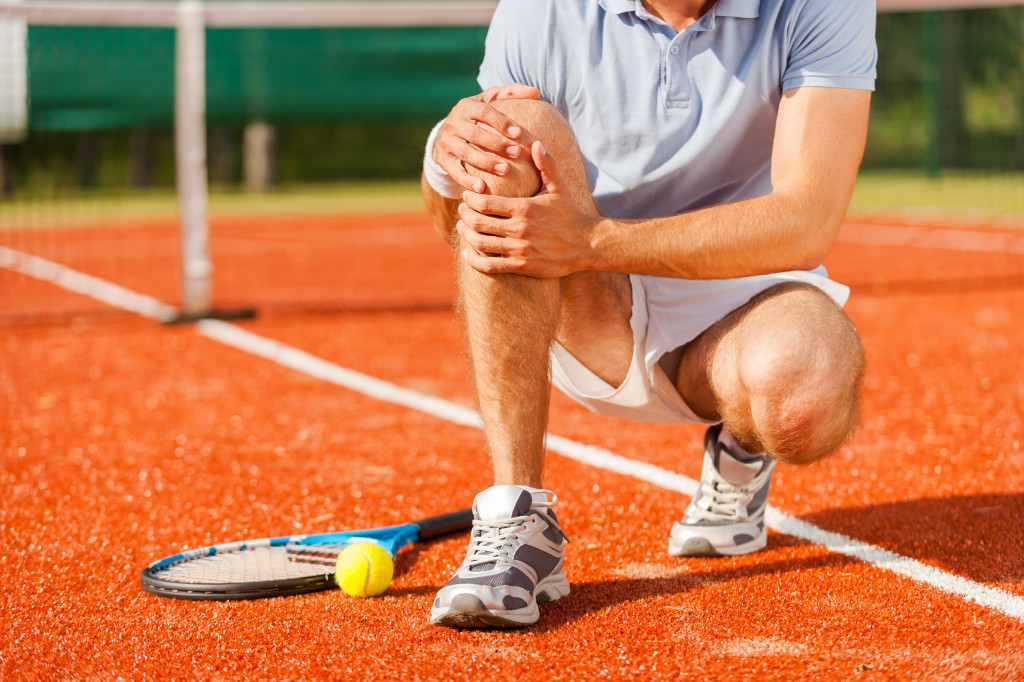Tennis isn’t as high-impact a sport as American football and basketball, but players are still prone to injury. In fact, two-thirds of tennis injuries result from overuse, while a third is attributed to traumatic or acute events.
So if you’re a casual tennis player and want to take care of your elbows and knees for weekend matches, watch out for these common tennis injuries.
Tennis Elbow
Tennis elbow happens when the tendons connecting the forearm muscles to the outside of the elbows become inflamed. This condition is also known as lateral epicondylitis and is commonly due to overuse. It’s prevalent among athletes, but it can also happen to non-athletes who don’t follow recovery periods. This is similar to golfer’s elbows, but while golfer’s elbows occur on the inside of the elbow, tennis elbows occur outside.
The symptom of tennis elbow is pain, which ranges from mild discomfort to severe pain. The person feels pain outside the elbow and experiences aches on the entire forearm when they lift or bend the arm. Sometimes, the person feels pain even if they don’t move their elbows.
Prevention
- Take Breaks. Don’t overuse your arms. If you feel that they’re sore, it’s usually a sign that they need a break.
- Warm Up and Cool Down. Warm-up exercises allow your muscles to be more flexible, while cool-down exercises return your heart gradually to a resting rate.
Jumper’s Knee
Also called patellar tendonitis, Jumper’s Knee occurs when the patellar tendon, which connects your kneecap to your shinbone, is inflamed. This is often the result of overuse of your knee joint. After all, repetitive jumping is part of tennis.
Symptoms of Jumper’s Knee include pain and tenderness around the knee and visible swelling. You may experience sharp pain when you jump, run, or walk. In some cases, it’s uncomfortable to bend or straighten your leg.
Prevention

- Warm Up and Cool Down. As with tennis elbows, a warm-up prepares the muscles and makes them more flexible, preventing knee injuries. Cooldown exercises, meanwhile, help restore your muscles to a relaxed state.
- Play at a Tennis Court. Try not to play tennis in places with very hard surfaces because these add stress to the muscles. Play at a tennis court instead.
- Wear Knee Support. To further prevent injuries, wear garments that protect and support the knees.
Stress Fractures
A stress fracture is a small crack in the bone, usually due to repetitive trauma or training that increased too fast. When muscles tire, more stress is placed on the bone. If the bone can’t stand up to the stress, it breaks.
In the case of tennis players, tennis serves are often the culprit. This move involves hyperextension of the back and puts a lot of stress on the vertebrae in the lower back, causing stress fractures. The main symptom of a stress fracture is pain in the area.
Prevention
- Keep a Steady Pace. Don’t train too hard too quickly — you have to give your body enough time to recover before taking your training to the next level. This way, your bones and muscles become used to a high amount of stress.
- Perform Endurance Training. On top of proper training, focus on endurance training. The goal of endurance training is to increase your body’s ability to withstand any activity for extended periods.
- Wear Appropriate Footwear. The right footwear will provide proper support to your feet and legs. If you have flat feet, ask your physician about arch supports.
Tips to Prevent Tennis Injuries
- Feed Your Muscles. Don’t deplete your muscles of energy. Athletes fuel their bodies with a healthy caloric intake. If possible and physician-approved, take supplements to help with any existing conditions. For instance, you could take supplements that lower your uric acid or sharpen your vision. Make sure, too, that your diet includes enough calcium and Vitamin D.
- Follow Proper Form. A lot of injuries are caused by improper technique. Work with an instructor or an experienced player to help you maintain proper form.
- Make Sure You Have the Right Gear. The right equipment will give you proper support as your jump and serve. For instance, tennis shoes support your ankles, while a good racquet reduces stress on your elbow and shoulder.
- If you don’t have an exercise routine yet, now is the time to start. Tennis requires full-body support, so it pays to strengthen every part of your body, even if you don’t have a match next weekend.
By following best practices in playing tennis, you’ll prevent injuries and spend many fun hours in court—with breaks, of course.

